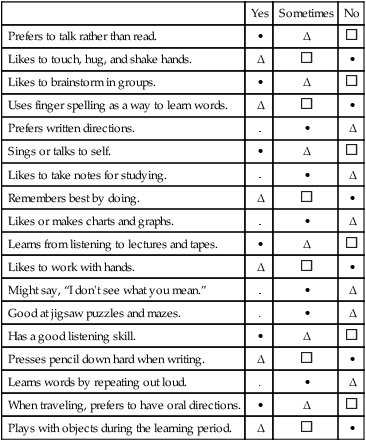On completing this chapter, you will be able to do the following: 1. Discuss brain dominance and its effect on learning. 2. Discuss characteristics of left-brain-dominant and right-brain-dominant learners. 3. Explain the relationship of two learning styles to brain dominance. 4. Describe three major perceptual learning styles. 5. Explain how your major learning style relates to your thinking style. 6. List and describe seven identified intelligences that affect learning. 7. Speculate on how your personality pattern influences your learning. 8. Explain what is meant by the following terms that are alternatives to linear note taking: mapping, clustering, idea sketches, diagramming, engaging in mental imagery. 9. Explain how a student with an undependable learning system such as untreated adult ADHD can learn successfully. 10. Discuss ways of dealing with additional barriers to learning. The two sides of the brain are designed to form a partnership. It is accepted that the left hemisphere of the brain is verbal and processes in sequence. The right hemisphere recognizes negative emotions faster, whereas the left hemisphere is more active when experiencing positive emotions. The left side of the brain is verbal and fluent, and without the help of the right side to add tone and inflection, it would make our speech robot-like. In school, the left side of the brain helps break down information so we can master it. The right side gives a total picture of our learning (Table 3-1). Table 3-1 Left and Right Hemispheres of the Cerebrum • Prefer a very structured approach to learning. They are most comfortable doing things in order. For example, when going to their first day of the nursing program, linear thinkers will have checked ahead of time the route they will take, which door to go in, where the room is located, the time they are expected to arrive, and what supplies they are expected to bring. • They will review the information carefully before leaving home. Global thinkers (also known as right-brain-dominant): • Observers: Visual learners have two subchannels: visual-linguistic and visual-spatial. Visual-linguistic learners learn best through reading and writing. They tend to remember what they read. They like to write down directions and pay better attention to traditional lectures if they watch them on video or a PowerPoint presentation. Visual-spatial learners do less well with reading generally, and they learn best through charts, demonstrations, videos, and other visual materials. They can easily visualize faces and places and seldom get lost in new surroundings. Observers tend to say, “I see what you mean” or “I think you mean. …” • Listeners: Auditory learners think in terms of hearing, talk to themselves, or hear sounds. They may move their lips and read out loud. They learn best by hearing and tend to have difficulty with reading and writing assignments. Listeners tend to say, “I hear what you are saying.” • Doers: Kinesthetic/tactual learners have two subchannels: movement and touch. They tend to lose interest during class if there is no movement or external stimulation. Kinesthetic learners experience feelings in regard to what is being thought about. They learn best by moving, doing, touching, experiencing, or experimenting. Sometimes learners with this style are categorized as slow learners because the information is not presented in their learning style. • Sit in the front seat of a face-to-face class. • Stay focused on the teacher’s facial expression and body language. • Take notes in class, and highlight, color code, and use mind maps to process and learn content. • Rewrite notes in your own words as a form of studying (e.g., write notes or draw pictures in the margin of your book or as a note on the screen). • Use index cards for review or memorization. • Review films or videos, DVDs, podcasts, and so on. • Look for reference books that contain pictures, graphs, or charts, or draw your own. • Request demonstrations and observational experiences before practicing a new skill. • Try to “picture” a procedure rather than just memorizing steps.
Learning Methods and Skills
How Do You Learn?
Brain dominance
Right and left sides of the cerebrum
Left Hemisphere
Right Hemisphere
Processes in sequence
Processes spatially
Trained musicians
Beginning music student
Verbal/fluent side
Among left-handed people, nearly half use right hemisphere for language
Robot-like speech
Adds tone and inflection to our voice
Higher-level mathematicians
More active during positive emotion
Chess players, problem solvers have more activation during tasks
Puzzles over missing part, such as a shaven beard
Recognizes negative emotions faster
Breaks down new information into bits and pieces so it can be mastered
Recognizes face in the crowd even if beard is shaved off
Gives a total picture of our learning
Thinking style
Learning styles
Perceptual learning style preference



Visual Learner
![]()
Stay updated, free articles. Join our Telegram channel

Full access? Get Clinical Tree


Learning Methods and Skills: How Do You Learn?
Get Clinical Tree app for offline access























 = visual • = auditory Δ = kinesthetic/tactile
= visual • = auditory Δ = kinesthetic/tactile

